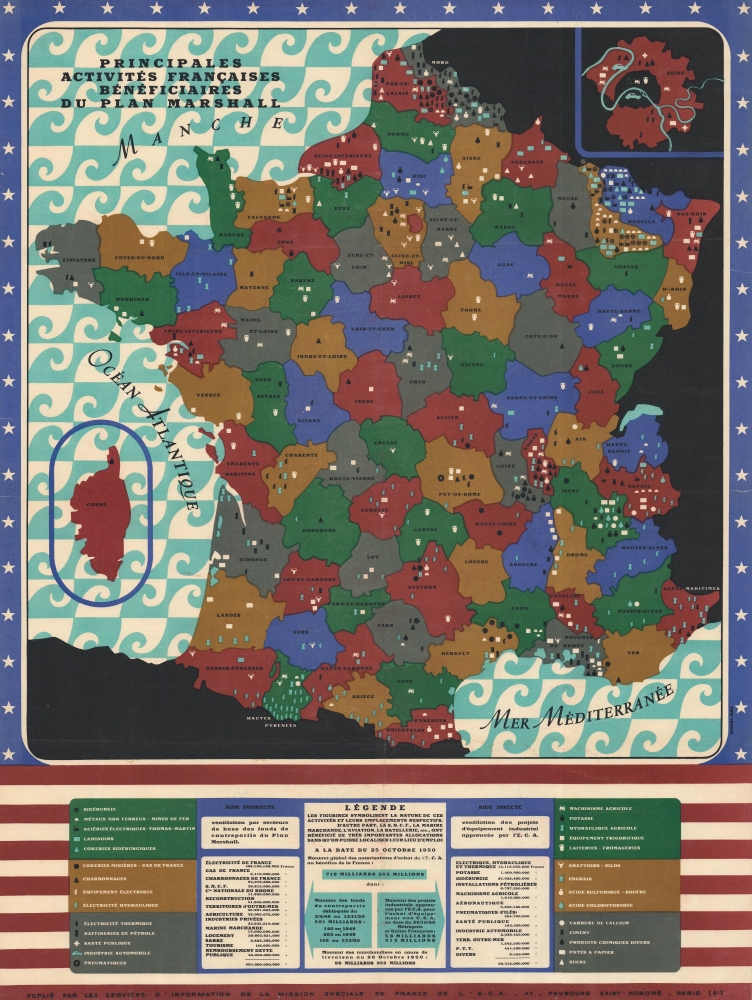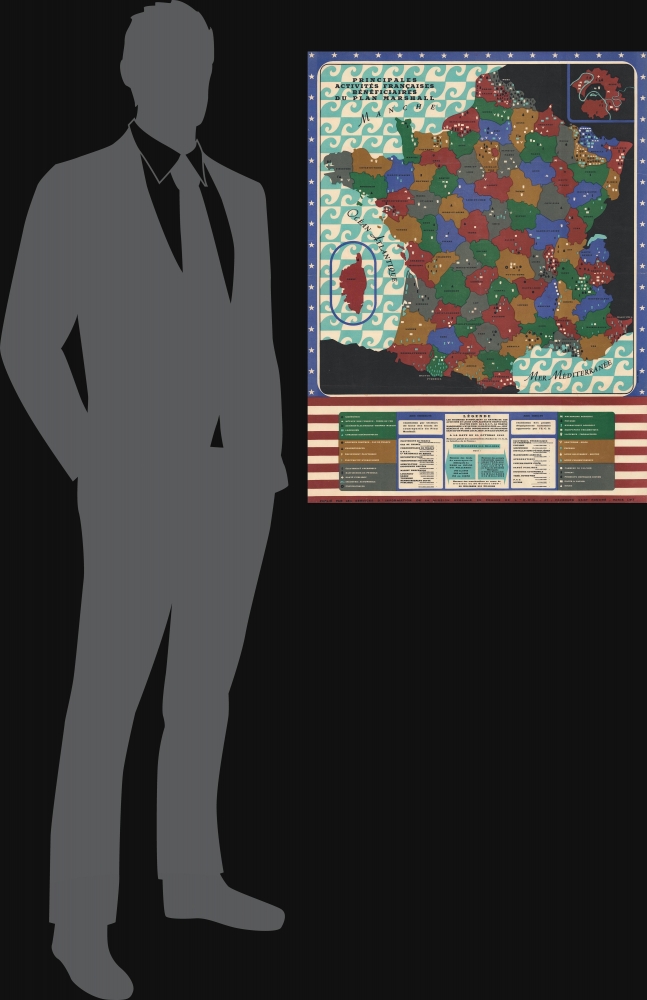1950 Infographic Map of France and the Marshall Plan
MarshallPlanFrance-eca-1950$800.00

Title
Principales Activités Françaises Bénéficiaires du Plan Marshall.
1950 (dated) 30.125 x 22.75 in (76.5175 x 57.785 cm) 1 : 1800000
1950 (dated) 30.125 x 22.75 in (76.5175 x 57.785 cm) 1 : 1800000
Description
This is a striking 1950 map of France published by the Economic Cooperation Administration (ECA) to highlight the achievements of the Marshal Plan - which at the time was in progress. The Marshall Plan was a post-World War II American-run economic stimulus initiative that infused some 13 billion USD into the Western European economy. While the effectiveness of the Marshall Plan has been debated, the inauguration of the plan marked a transition of American foreign policy from pre-war isolationism to post-war economic imperialism. The imperialist message underpinning this map is not subtle, with the map of France set against a backdrop of, and wholly contained within, an American Flag.
May claim that the Marshall Plan was ineffective and, while economies did recover at a breakneck pace, argue that the economic stimulus was not major factor in post-war prosperity. Others argue that the entire effort was American Imperialism that forced entire nations to take on massive U.S. controlled debt. As it may be, the Marshall Plan was likely more effective in the secondary goal of reducing the spread of Communism by tying recipient countries more tightly to American money and values.
A Closer Look
The map embraces all of France with insets of the environs of Paris and Corsica. Industries propped up by the Marshall Plan are illustrated via a coded icon system. These include public services, as well as, steel, automobile, hydroelectric, cement, tire, and other industries. An expansive legend at bottom elucidates the icons and breaks down the distribution of aid. An American Flag forms the background and border.The Marshall Plan
Enacted in 1948, the Marshall Plan (European Recovery Program) was an American program that provided recovery aid to Western Europe. Over $13 billion was provided (the equivalent of about $115 billion in 2021) to rebuild the economies and infrastructures of war-torn Western Europe. The whole program, while an important step to increasing prosperity across the region, was more subtly aimed at curbing Communism. The United Kingdom was the largest recipient (26%), followed by France (18%) and West Germany (11%). In total, 18 countries received aid. The U.S. offered the Soviet Union Marshall Plan aid but was rebuffed, and further demanded Eastern Bloc countries also refuse the aid.May claim that the Marshall Plan was ineffective and, while economies did recover at a breakneck pace, argue that the economic stimulus was not major factor in post-war prosperity. Others argue that the entire effort was American Imperialism that forced entire nations to take on massive U.S. controlled debt. As it may be, the Marshall Plan was likely more effective in the secondary goal of reducing the spread of Communism by tying recipient countries more tightly to American money and values.
Publication History and Census
This map was created and published by the Information Service of the Special Mission to France of the Economic Cooperation Administration. We note a single cataloged example which is part of the collection at the University of Illinois at Urbana Champaign.Cartographer
The Economic Cooperation Administration (ECA) (1948 - 1951) was an agency of the U.S. government created to administer the Marshall Plan in 1948. Reporting to both the Department of Commerce and the State Department, the ECA maintained offices in the capitals of all sixteen countries that participated in in the Marshall Plan. The agency existed until 1951, when the Mutual Security Agency succeeded it, and is one of the predecessors of the United States Agency for International Development. More by this mapmaker...
Condition
Very good. Closed margin tears professionally repaired on verso. Closed tear extending one (1) inch into printed area professionally repaired on verso. Light wear along original fold lines. Light soiling. Verso repairs to fold separations.
References
OCLC 1038017788.




